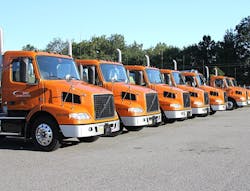With the trucking industry short on drivers – with average age of the current driver pool skewing older and older – fleets are deploying a wider range of tactics to entice workers to pilot big rigs for a living.
That includes using “friends and family” as a recruiting tool; an effort one carrier, A. Duie Pyle, is placing more focus upon.
“We already use what we call an ‘active internship’ program that provides an opportunity for summer work to the sons and daughters of current employees – especially on our freight docks,” Randy Swart, Pyle’s COO, told Fleet Owner.
“Many of them have gone on to work in various areas of our company full time, such as customer service or marketing,” he added. “What we’ve found is that as friends or family members of current employees, they understand what we expect in terms of hard work, ethics, etc. So in many ways they already understand our core values from the start.”
To that end, Pyle revamped its “friends and family” recruiting program this year, providing select drivers with a “business referral card” with the web address for an online application.Recruits enter the name of the person who recruited them on their form and, if they get hired, the employee gets a referral bonus, Swart said.
The carrier also offers truck driving training schools at its West Chester, PA, and Northborough, MA, locations and has put about 250 drivers through the program over the last seven years.
Yet Pyle is also specifically trying to encourage more driver applications from the families of those already operating its tractor-trailers.
The Lighty generation represents one such “multi-generational” success story for the Northeastern region carrier, with Walter Lighty Jr., 67, Walter Lighty III, 50, and Walter Lighty IV, 25, all employed as Pyle drivers.
Lighty Jr. and Lighty III were veteran truck drivers, with decades spent on the road with LTL carriers Preston freight Service and Consolidated Freightways – both now defunct – before joining Pyle 15 years ago.
Lighty iV originally started at Pyle at age 18, working the freight dock part time while going to college. When school didn’t work out, he started looking for a full-time job, ending up in the driver’s seat like his father and grandfather.
“I originally didn’t want to be a truck driver,” he told Fleet Owner. “But like dock work, I proved good at it. I’m especially good at maneuvering my truck in tight spaces.”
Lighty III noted that it’s rare for all three generations of the family to see each other at work, since each works different routes – Lighty Jr. likes longer-haul over-the-road freight, while Lighty III and IV prefer more localized pickup and delivery – and shifts.
Yet the recruiting forecast for truck drivers remains decidedly grim.
Out of the total U.S. labor pool, approximately 7 million persons hold trucking-related jobs with 3.2 million employed as truck drivers. However, American Trucking Associations (ATA) data indicates that the industry is suffering a shortage of between 30,000 and 35,000 drivers right now, which could grow to 240,000 drivers by 2022 when aligned with freight growth forecasts.
Still, Pyle’s Swart stressed that what the carriers when recruiting from friends and family are drivers that intimately understand company expectations right from the get-go – and are likely to stay long term.
“When we recruit via friends and family, we’re almost always getting a ‘known commodity,’ somebody that knows what we expect. That’s the insight we get from recruiting this way,” he explained. “It also increases the likelihood that they will stay long term.”
Yet John Larkin, managing director & head of transportation capital markets research for Wall Street investment firm Stifel Nicolaus & Co., noted recently that carriers are deploying a broader array of driver-focused retention efforts including:
- Increasing pay, which by some estimates has gone up 14% overall;
- Getting drivers home more frequently and more regularly;
- Buying trucks outfitted with the latest driver friendly amenities;
- Reducing the driver to fleet manager ratio in order to increase driver/fleet manager communication;
- Building driver-friendly lounges, cafeterias, exercise rooms, and bunk houses at or near terminals;
- Proving health improvement programs;
- Building or developing more driver training schools.
“The driver recruiting and retention issue remains the number one challenge facing the industry today,” Larkin emphasized.




